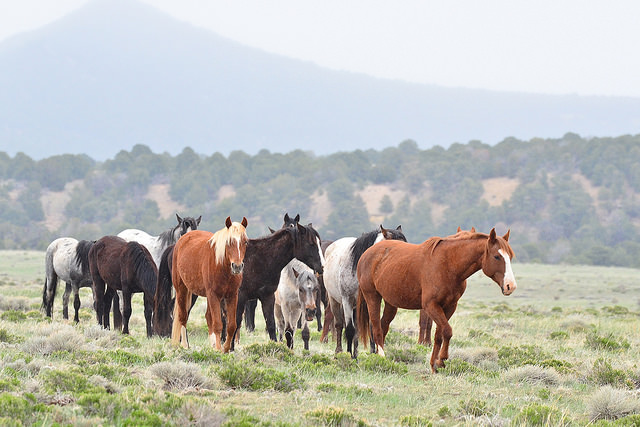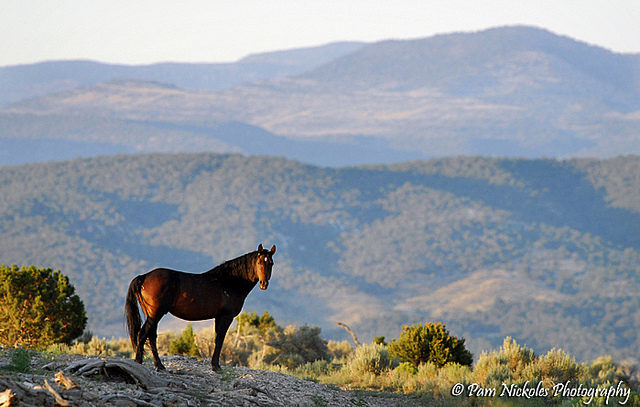The following story is based on a recent report issued by the U.S. Interior Department Office of the Inspector General regarding the rancher, Tom Davis, and his dealings with the Bureau of Land Management’s Wild Horse and Burro Program during the years of 2008-2012. The report was released to the public on October 23, 2015.
Once upon a time, not so very far away, there was an industrious Colorado rancher named Tom Davis. Tom had always been an enterprising fellow, and when he was a young man, he worked on racetracks and ranches out West, where he would occasionally round up wild horses and sell them for their meat. But in 1971, The Wild Free-Roaming Horses and Burros Act changed all that for Tom, at least for a while.
These were just some of the things that Tom Davis told Dave Philipps for Pro Publica in their two-hour interview back in 2012. During that talk, the rancher went on about making his living selling and hauling horses, about his fondness for “fat yearling colt” meat, and about his enduring regard for the horses of the American West, one that he even compared to an addiction. “I love wild horses to death,” he said.
Davis also spent time talking about his friends in government, specifically his old neighbor in La Jara, Colorado, Ken Salazar. Ken was a former U.S. Senator who at that time headed the Department of the Interior. But Ken and Tom went way back. When he was a boy, Tom said, he and his father would farm the Salazar’s land, and he and Ken had stayed in touch. These days, Tom told Philipps, he still did some business for Ken, including “quite a bit of trucking”.
Tom also did some business with the American Bureau of Land Management, or the BLM. Back in 1999 and the early 2000s, according to the U.S. Interior Department Office of the Inspector General’s recently released investigative report, Davis adopted 24 horses through the organization’s Wild Horse and Burro Program (WH&B), and he must have developed a taste for it. Luckily, an amendment passed by Congress a couple of years later would make Tom’s thirst for wild horse adoption even easier than before. Now as then, there are more than 47,000 captured wild horses and burros living in WH&B-maintained off-range corrals and pastures, at an annual cost of more than $43 million a year.
In 2004, the Burns Amendment was passed to help the BLM trim the fat, so to speak, on its off-range herds. Any horse over the age of 10 or that had failed to be adopted on more than three occasions could be sold “without limitation” to auctions, sale yards, livestock selling facilities, or the like, to the highest bidder. A year later, the BLM refined its language, adding a limit to the number of wild horses that could be sold to a buyer, and requiring those buyers to provide “good homes and humane care” for their adoptees. In 2009, Congress weighed-in again as well, adding a 2010 proviso that stated that no funds could be used “for the destruction of healthy, unadopted, wild horses and burros in the care of [BLM] or its contractors or for the sale of wild horses and burros that results in their destruction for processing into commercial products.”
All that is to say, the BLM was left with a surplus of expense-generating horses in its captured herds, and rather specific instructions as to how those horses could be re-homed. Specific, but not explicit. And the BLM did have one man in their corner: an eager, hard-working, wild horse lover named Tom Davis. In fact, between 2008 and 2012, Davis purchased 1,794 horses and burros from the BLM’s WH&B, which he bought quite literally by the truckload—about 35 horses in each. The rancher paid $10 a horse and re-sold them for $3,500 to $4,000 a load, often making a tidy little profit of $2,500 to $3,000 on each trailer-full of animals he took home.
Now this may seem like a lot of money and horses to be changing hands, and in fact, for the BLM, it was. After Tom’s 1,794 horses, the next-largest purchase by a single buyer was just 325 horses. But the BLM and their ace-in-the-hole rancher remained on friendly terms, with the former even delivering the animals directly to Tom’s doorstep, as was their custom for purchases of 20 or more wild horses. Tom spent just under $18,000 to buy the animals, and the BLM spent $140,000 transporting them.
But Tom did have a bit of paperwork to take care of. For each truck of horses, Davis completed a bill of sale stating that he wouldn’t knowingly sell or transfer ownership of any of the horses in his care to a person or organization with the intent to resell them to slaughter. And for his first large-scale adoption in January, 2008, he was required to complete an over-the-phone application with a BLM marketing specialist, who asked him what he was planning to do with the horses. Tom told her he might sell them, but not to slaughter. He said he’d send them all off to good homes. And so just like that, Tom’s application was approved, and the BLM loaded up their truck and headed over to Tom’s ranch.
According to BLM protocol, Tom Davis shouldn’t have needed to complete another interview for each new batch of horses, and for a couple of years, he didn’t. But then, in January, 2011 and again in April, 2012, the BLM decided to update their sales application form, and so Tom had to answer some more questions. Why did he want more horses? What was he planning to do with all of them? He’d turn them out on oil leases to graze, Tom wrote, or he’d sell them off to good homes as pasture pets. People are taking them in these days in groups of 10 to 30, he indicated. But who are you selling them to?—the marketing specialist wanted to know on a few occasions. Tom declined to answer, telling her he didn’t want the BLM “honing in” on his market. Okay, agreed the marketing specialist. Down came the rubber stamp, and Tom got another load of horses.
*****
But all these wild horses funneling out of BLM holding pens were raising some eyebrows over at the U.S. Department of the Interior, and public complaints were starting to light up the phones at the WH&B offices. Archived department emails reviewed after the fact by the Inspector General’s investigative committee indicate that there was some concern back in Washington about what Tom was really doing with all those trailers full of mustangs. But Congress was in a bind. Methods like fertility controls or expanding the land available to wild horses or even introducing natural predators into wild horse territories were proving either undesirable or unsuccessful for the BLM. And other alternatives—such as offering unlimited sales on horses or even destroying them—was deemed by one WH&B senior advisor to be akin to “political suicide”.

Nevada wild horses for adoption. (flickr.com/BLM Nevada)
In 2011, the marketing strategist and a WH&B senior advisor put another call into Tom. They had some of the same old questions to ask, and Tom had some of the same old answers to give them. The horses were fine. They weren’t being resold for slaughter. He’d pawned them off on wealthy friends who let them hang around on their property in exchange for fat tax breaks. The senior advisor took Tom at his word, and didn’t ask for names. “No evidence of wrongdoing” went down in Tom’s file. If there were more questions to be asked, the senior advisor later said, it wasn’t the WH&B’s job to ask them.
In June of 2012, the BLM’s Office of Law Enforcement decided that they might also like a word with Tom Davis, and interviewed him twice. But the uniforms didn’t determine that any of Tom’s horses were going to slaughter either. And besides, they were kept well informed about the rancher’s habits by the marketing specialist, who dutifully gave Tom a call every time she received a complaint, and then let the Office of Law Enforcement know about it too. But in the end, the marketing specialist’s job performance evaluations were based on how many adoptions and sales she had on the books, and between 2008 and 2012, she was quite the department star. Appraisal ratings from that period in her record were either “exceptional” or “superior”, and she had the monetary bonuses to prove it.
Even if the lights hadn’t come on yet for everyone else at the Department of the Interior, though, it was last call, and the party was just about over. A few months after the Office of Law Enforcement conducted their interviews, the Inspector General opened their own independent investigation on Tom Davis. By now, the public was starting to have some very serious concerns about how the WH&B was running their adoption program. You see, in late September of 2012, an NBC news article reported that Tom Davis, the #1 adopter of wild horses in America by a wide margin, had been looking into investors for a slaughterhouse operation. The story also alleged that Tom and former Secretary of the Interior Ken Salazar were old buddies and, worse still, that the BLM had started to send Davis truckloads of horses back in 2009, just two weeks after Salazar was selected for his new position. (According to this report, it seems Tom was approved for his first truckload of horses a year before Salazar took office in January, 2009.)
The Inspector General got right to work, and they started with Tom Davis, himself. This was a good idea. When asked how many of the 1,700 horses that he purchased from the WH&B were sent to Mexico, Tom simply replied: “Probably close to all.” They were the “un-adoptables”, he went on, the horses that the BLM had to get rid of, and he was the man to help them do it. If he received any “good” horses in the mix, it was probably no more than one a truckload. Plus, Tom said, he never crossed into Mexico himself. But did he tell the marketing specialist during any of the times that she had asked him that he wouldn’t sell the horses off to slaughter? Well, yes, he did tell her that, and yes, he knew he wasn’t supposed to do it anyway. But Tom knew where the horses were going, he said, because there was only one place for them to go. “The kill plant.” And he wasn’t done yet.
Tom said if he could get 10,000 horses from the BLM and bypass his buyers, he would take them directly to Mexico himself, sell them for $10 a piece, and be set for life. He wouldn’t say who his buyers were, directly, but it didn’t take long for the investigators to work out who one of them might be. The owner of the Lunas, New Mexico-based Southwest Livestock, LLC was “a friend” of Tom’s and a well-known kill buyer, transporting a reported 12,000 horses a year from the U.S. to Mexican slaughterhouses. Tom said his friend didn’t transport any BLM horses, which would have been identifiable by their freeze-marked brand. But subpoenaed financial and business records from both Davis and the owner of Southwest Livestock told a different tale. Many of the horse transactions between Tom and Southwest, made within days of Tom’s BLM adoptions, matched up almost perfectly: 36 horses from the BLM to Tom on February 12th, for example, and 39 horses from Tom to Southwest on February 18th. Subpoenaed phone records also showed numerous calls between the two dealers that corresponded with the periods in question.
When the Inspector General contacted Southwest Livestock, they quickly lawyered up. So instead they went to another source: New Mexico’s brand inspectors who, along with a USDA-certified veterinarian, must inspect all of Southwest Livestock’s horses before they cross the border into Mexico. The brand inspector was asked if he performed inspections on animals transported from Southwest Livestock’s facility. Yes, the brand inspector said, routinely. But did you check the horses for a freeze-marked brand? Well, no, the man admitted, he relied on the accuracy of the paperwork provided by Tom’s friend, Southwest Livestock’s owner. And what about the vet, who needed to inspect the horses and sign off on International Health Certificates before their export to Mexico? The certificates were prepared in advance by Southwest Livestock, the vet said, so he didn’t actually look over any horses. And so, no, he wouldn’t know if any of them had a freeze-marked brand either.
Then there was that other friend of Tom’s, the 50th Secretary of the Department of the Interior, Ken Salazar. It seems that as much as Tom loved talking with reporter Dave Philipps about Ken Salazar, Ken Salazar didn’t much like talking to Dave Philipps about Tom, and at one point even threatened to punch Dave out for asking. So the Inspector General asked BLM employees if they knew of any relationship between the Secretary and Tom Davis. BLM employees said nope, and the Inspector General concluded that the matter, “did not warrant further investigation.” It’s worth noting, however, that while the report includes the fact that Ken Salazar declined to speak with reporter Dave Philipps back in 2012, the Inspector General’s findings do not indicate that they at any time questioned the former Secretary of the Interior directly. This, despite being one of two stated allegations that the Inspector General set out to investigate.
The government referred their findings on Tom Davis to the U.S. Attorney’s Office for the District of Colorado and the State of Colorado Conejos County District Attorney’s Office. Both declined to prosecute. The Inspector General also referred their findings on the USDA-certified veterinarian who admitted to falsifying International Health Certificates without inspecting the horses to the U.S. Attorney’s Office for the District of New Mexico. They declined to prosecute as well. And so the U.S. Interior Department’s Office of the Inspector General sent their findings back to the U.S. Interior Department’s Bureau of Land Management, where the Deputy Director of Operations, Stephen Ellis, issued the following response:
“Thank you for your memorandum of July 7, 2015, transmitting the results of your office’s investigation of Mr. Tom Davis. The BLM is committed to ensuring all agency operations follow relevant law and policy, and I appreciate the important role of the Office of lnspector General in carrying out that commitment. I have carefully reviewed your report and respectfully submit this response.
The BLM takes very seriously your finding that most of the 1,700 horses sold to Mr. Davis went to slaughter contrary to the tenns of the BLM’s sale and in spite of a series of preventative measures followed by the BLM during the sale to Mr. Davis. The BLM has taken additional steps to strengthen our ability to prevent this type of situation from happening…
With respect to Mr. Davis, the BLM no longer has any business relationship with Mr. Davis and will not in the future. As you note, both the U.S. Attorney’s Office for the District of Colorado and the State of Colorado Conejos County District Attorney’s Office have declined civil and criminal prosecution. Accordingly, there is no further action that the BLM may take specific to Mr. Davis.
Thank you for your assistance in this matter.”


 October 28, 2015
October 28, 2015 



























